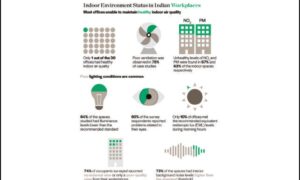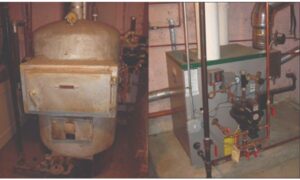Indian building sector has realised the importance of energy efficiency but it is yet to be effectively integrated in the construction industry. Smart, dynamic shading devices to keep rooms cool in climate zones and latitudes of India and low energy technologies for air-conditioning can help progress towards energy efficiency in the country, a large part of which experiences high-temperature conditions.
The Energy and Resources Institute (TERI) in partnership with the Department of Science & Technology, Government of India has developed novel external shading solution for windows in residential and commercial buildings under the project Habitat Model for Efficiency and Comfort. The shading system named as “ShadeSmart” has been developed as an innovative and cost-effective solution for achieving indoor comfort with reduced electricity consumption in air conditioning and lighting.
External shading devices are not common in modern buildings, which are mostly glazed or buildings with curtain walls. They are usually permanent structures, posing challenges such as maintenance, obstruction of views, architecturally not meeting the aspirations of the client, and so on. In contrast, ShadeSmart changes its configuration depending upon the Sun’s position. For example, when the Sun is in the East direction, East façade windows will be shaded, once the Sun is in South orientation during noon ShadeSmart configuration on East changes to provide unobstructed external views and glare-free daylight.
The criterion of design for residential and commercial buildings substantially differs due to differences in activity and occupancy patterns, each design derived through a unique methodology ensuring highest benchmarks of comfort and energy efficiency. The performances of each of these designs have been tested through software simulation as well as real-time field measurements attest beds.
ShadeSmart is being commercialised, and efforts are being made to make ShadeSmart more affordable than air conditioning in small thermal zones next to external windows, especially in the residential sector. This technology will help to bring inside the buildings more daylight with less heat, thus making occupants comfortable and also more productive and healthy.
In the international market, many movable shading devices are available, however, since ShadeSmart is locally produced in India, it becomes an economically viable energy-efficient solution which every building may integrate in order to achieve energy efficiency.
Radiant cooling perceived COVID safe
The second technology, Radiant Cooling, where cooling is achieved through radiant heat transfer, as against regular convective air conditioning is efficient and gives better quality of thermal comfort. At present, energy and comfort audits of existing radiant cooled buildings, energy simulations, and finally, construction of a Demonstration Habitat is being undertaken. Besides, the process to integrate radiant cooling in the National Building Code is being undertaken.
Radiant cooled buildings have an extremely high potential of energy-saving (60-70 percent). Standard protocols for operation of radiant cooled buildings and adaptive thermal comfort standards for radiant cooled buildings in India will make it convenient for the masses to adopt radiant cooling technology.
Low energy hybrid cooling technologies and control mechanisms in radiant cooled buildings is being demonstrated along with the industry partners. The availability of such technology at an affordable cost will help reduce our dependency on imported products.
Due to the COVID 2019 Pandemic, conventional air cooling, which involves re-circulation on return air, is being perceived as harmful to the health of occupants. In this scenario, Radiant Cooling, which employs 100 percent fresh air supply, is expected to gain popularity and higher acceptance rates in the air-conditioning industry. Hence establishing adaptive comfort bands and operating protocols of radiant cooled buildings can help the buildings sector adopt this low energy cooling technology. Work on Patentability Report has been initiated, and patent is being filed for ShadeSmart.
ShadeSmart & Radiant Cooling technologies promote energy-efficient cooling in buildings
Cookie Consent
We use cookies to personalize your experience. By continuing to visit this website you agree to our Terms & Conditions, Privacy Policy and Cookie Policy.














